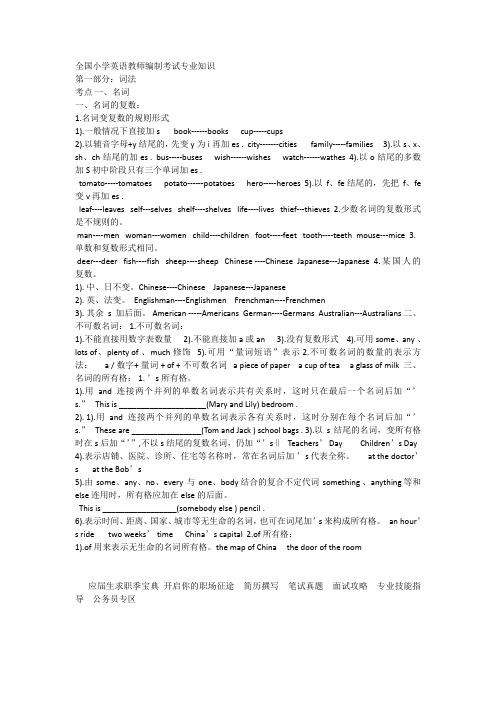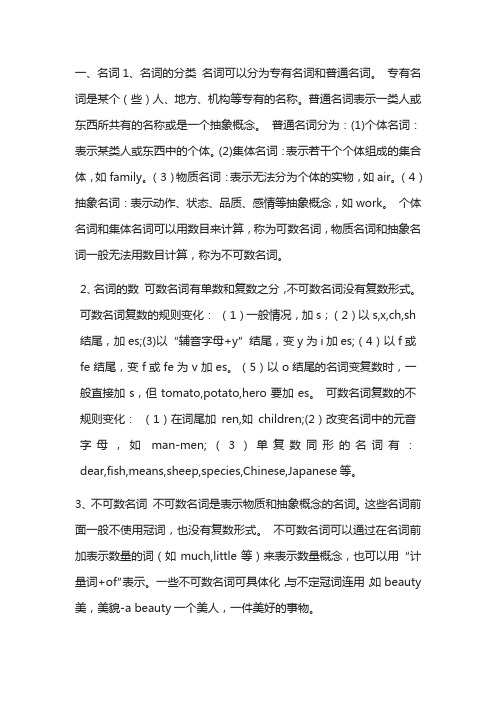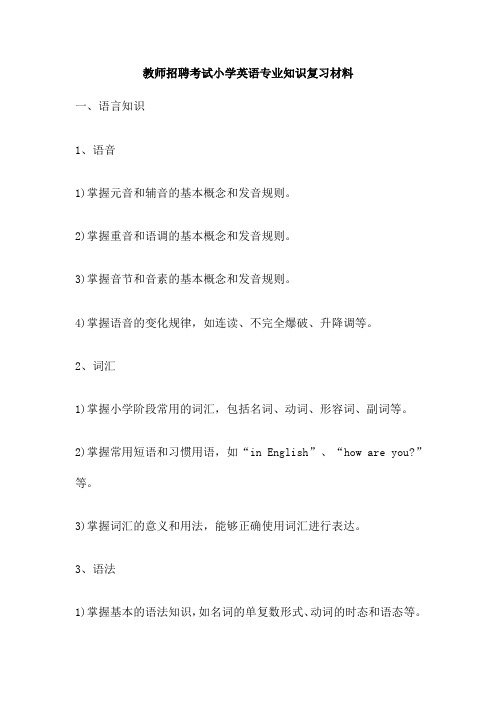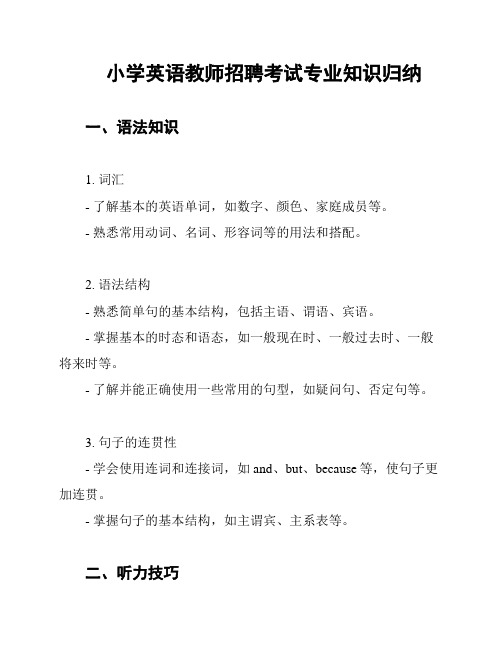教师考编复习资料——英语
- 格式:doc
- 大小:80.00 KB
- 文档页数:24

中小学英语教师招聘考试基础知识复习资料三代词(一) 知识概要英语中代词可以分为人称代词、物主代词、反身代词、指示代词、疑问代词、不定代词。
人称代词主要有主格和宾格之别。
请看下表人称我你他她它我们你们他们主格 i you he she it we you they宾格 me you him her it us you them物主代词分形容词性物主代词和名词性物主代词两种。
请看下表?人称我的你的他的她的它的我们的你们的他们的形容词性 my your his her its ours your they名词性 mine yours his hers its ours yours theirs反身代词可见下表人称我你他她它我们你们他们反身代词 myself yourself himself herself itself ourselves yourself themselves指示代词主要有this, that, these, those疑问代词有:who, whom whose, what, which,还有疑问副词when, how, where, why。
不定代词在初中课本中主要有some, any, many, much, each,neither, other, another, all, both, one, none, either…(二) 正误辨析[误]Tom's mother is taller than my.[正]Tom's mother is taller than mine.[析]形容词性物主代词可以作定语,也就是讲它可以作形容词,如:my book,而这句话的意思是:汤姆的妈妈比我的妈妈高。
比较的对象是my mother,也就是mine。
[误]We have a lot of homework to do today. So we need two or three hours to finish them.[正]We have a lot of homework to do today. So we need two or three hours to finish it.[析]在应用代词时,要注意人称,格与数的一致性。

全国小学英语教师编制考试专业知识第一部分:词法考点一、名词一、名词的复数:1.名词变复数的规则形式1).一般情况下直接加s book------books cup-----cups2).以辅音字母+y结尾的,先变y为i再加es . city-------cities family-----families 3).以s、x、sh、ch结尾的加es . bus-----buses wish------wishes watch------wathes 4).以o结尾的多数加S 初中阶段只有三个单词加es .tomato-----tomatoes potato------potatoes hero-----heroes 5).以f、fe 结尾的,先把f、fe 变v 再加es .leaf----leaves self---selves shelf----shelves life----lives thief---thieves 2.少数名词的复数形式是不规则的。
man----men woman---women child----children foot-----feet tooth----teeth mouse---mice 3.单数和复数形式相同。
deer---deer fish----fish sheep----sheep Chinese ----Chinese Japanese---Japanese 4.某国人的复数。
1). 中、日不变。
Chinese----Chinese Japanese---Japanese2). 英、法变。
Englishman----Englishmen Frenchman----Frenchmen3). 其余s加后面。
American -----Americans German----Germans Australian---Australians 二、不可数名词: 1.不可数名词:1).不能直接用数字表数量 2).不能直接加a或an 3).没有复数形式 4).可用some、any 、lots of、plenty of 、much 修饰 5).可用“量词短语”表示 2.不可数名词的数量的表示方法: a / 数字+ 量词 + of + 不可数名词 a piece of paper a cup of tea a glass of milk 三、名词的所有格: 1. ’s 所有格。

小学英语教师招聘考试(英语学科知识)整理Part 1: ___Chapter 1: Primary School English Curriculum Standards1.The nature of the English curriculum: ___.2.The basic philosophy of primary school English curriculum:1) ___。
reflecting the value of language learning for students' development.2) Targeting all students。
paying n to the different ___.3) Overall design goals。
___.4) Emphasis on learning process。
___.5) Optimizing ___。
___.6) Enriching curriculum resources。
___.3.Design ideas of the English curriculum: There are nine levels。
starting from the third grade of primary school。
The first level is the requirement for grades three and four。
and the second level is the target requirement for grades five and six。
By the end of ninth grade。
students should reach level five。
and by the end of sixth grade。
they should reach level two。
(P18)4.The overall goal of the English curriculum: to enable students to form ___ n abilities。

一、名词1、名词的分类名词可以分为专有名词和普通名词。
专有名词是某个(些)人、地方、机构等专有的名称。
普通名词表示一类人或东西所共有的名称或是一个抽象概念。
普通名词分为:(1)个体名词:表示某类人或东西中的个体。
(2)集体名词:表示若干个个体组成的集合体,如family。
(3)物质名词:表示无法分为个体的实物,如air。
(4)抽象名词:表示动作、状态、品质、感情等抽象概念,如work。
个体名词和集体名词可以用数目来计算,称为可数名词,物质名词和抽象名词一般无法用数目计算,称为不可数名词。
2、名词的数可数名词有单数和复数之分,不可数名词没有复数形式。
可数名词复数的规则变化:(1)一般情况,加s;(2)以s,x,ch,sh 结尾,加es;(3)以“辅音字母+y”结尾,变y为i加es;(4)以f或fe结尾,变f或fe为v加es。
(5)以o结尾的名词变复数时,一般直接加s,但tomato,potato,hero要加es。
可数名词复数的不规则变化:(1)在词尾加ren,如children;(2)改变名词中的元音字母,如man-men;(3)单复数同形的名词有:dear,fish,means,sheep,species,Chinese,Japanese等。
3、不可数名词不可数名词是表示物质和抽象概念的名词。
这些名词前面一般不使用冠词,也没有复数形式。
不可数名词可以通过在名词前加表示数量的词(如much,little等)来表示数量概念,也可以用“计量词+of”表示。
一些不可数名词可具体化,与不定冠词连用,如beauty 美,美貌-a beauty一个美人,一件美好的事物。
4、名词的所有格名词所有格用来表示人或物的所属关系。
包括’s所有格、of所有格和双重所有格。
基本用法:(1)表示有生命的名词的所有格其单数形式加's,其复数形式是s';(2)结尾不是s的复数名词仍加’s;(3)表示时间、距离、长度、重量、价格、世界、国家等的名词的所有格要用's(4)无生命名词的所有格则必须用of结构;(5)如果两个名词并列,并且分别有's,则表示“分别有”;两个名词并列,只有一个's,则表示“共有”;(6)'s还可以表示某人的家或者某个店铺。

教师招聘考试小学英语专业知识复习材料一、语言知识1、语音1)掌握元音和辅音的基本概念和发音规则。
2)掌握重音和语调的基本概念和发音规则。
3)掌握音节和音素的基本概念和发音规则。
4)掌握语音的变化规律,如连读、不完全爆破、升降调等。
2、词汇1)掌握小学阶段常用的词汇,包括名词、动词、形容词、副词等。
2)掌握常用短语和习惯用语,如“in English”、“how are you?”等。
3)掌握词汇的意义和用法,能够正确使用词汇进行表达。
3、语法1)掌握基本的语法知识,如名词的单复数形式、动词的时态和语态等。
2)掌握句子的基本结构,如主语+谓语+宾语、主语+谓语+表语等。
3)掌握常见的句型和表达方式,如“It's time to do sth.”、“How many…are there?”等。
二、语言技能1、听1)能够听懂简单的英语对话和短文,并理解其中的含义。
2)能够根据听力材料做出简单的反应和回答。
2、说1)能够用简单的英语进行交流和表达,包括自我介绍、日常对话等。
2)能够根据话题进行简单的口头作文,如描述自己的家庭、描述一个物品等。
3、读1)能够阅读简单的英语短文和故事,并理解其中的含义。
2)能够根据阅读材料回答问题,并提取关键信息。
4、写1)能够书写简单的英语短文和作文,并表达自己的观点和想法。
2)能够根据写作要求完成命题作文或日记等。
小学英语教师招聘考试专业知识随着全球化的不断深入,英语教育在中国的地位日益显著。
小学英语教育作为基础阶段的教育,对于学生的英语学习生涯具有深远的影响。
因此,对于小学英语教师的招聘,专业知识与技能的考核至关重要。
本文将探讨小学英语教师招聘考试专业知识的重要性以及具体内容。
一、专业知识的重要性1、提升教学质量:小学英语教师必须具备扎实的英语基础知识和语言技能,以便更好地理解和教授英语。
专业知识不仅有助于教师准确发音,掌握语法规则,还能让他们更好地理解英语的文化背景和使用环境。

小学英语教师招聘考试专业知识归纳
一、语法知识
1. 词汇
- 了解基本的英语单词,如数字、颜色、家庭成员等。
- 熟悉常用动词、名词、形容词等的用法和搭配。
2. 语法结构
- 熟悉简单句的基本结构,包括主语、谓语、宾语。
- 掌握基本的时态和语态,如一般现在时、一般过去时、一般将来时等。
- 了解并能正确使用一些常用的句型,如疑问句、否定句等。
3. 句子的连贯性
- 学会使用连词和连接词,如and、but、because等,使句子更加连贯。
- 掌握句子的基本结构,如主谓宾、主系表等。
二、听力技巧
1. 听懂基本的日常英语对话,如问候、介绍自己、询问他人情
况等。
2. 培养听力理解能力,可以通过听录音、看英语电影等方式进
行练。
3. 注意细节和关键词,帮助理解整个对话的内容。
三、口语表达
1. 提高口语表达能力,包括语音语调、正确发音等。
2. 学会运用简单的日常用语,如问路、购物、点餐等。
3. 练日常情景对话,增加口语流利度和表达自如的能力。
四、阅读理解
1. 阅读简单的英语短文,理解文章的主题和大意。
2. 提高阅读速度和准确度,通过不断阅读来增加词汇量和语感。
3. 注意上下文的关联,理解词语和句子之间的逻辑关系。
五、写作技巧
1. 学会书写基本的英文字母和单词,保持字迹清晰。
2. 练写作简单的句子和段落,如日记、介绍自己等。
3. 锻炼写作思维,提高表达清晰、逻辑性强的能力。
以上是小学英语教师招聘考试的专业知识归纳,希望对您的备考有所帮助!。
教师招聘英语专业知识复习资料名词性从句1、主语从句在复合句中充当主语成分的句子。
其时态不受主句的时态影响和限制。
引导主语从句的连词有that,whether,who,what,whatever等;连词位于句首不能省略;主语从句大多数情况下视为第三人称单数,但也有例外。
为了整个句子的平衡,主语从句经常后置,并用it充当形式主语。
It is+过去分词+that从句中,常用的过去分词有said,reported,decided,believed,suggested,ordered等。
过去分词为suggested,ordered等表“建议,命令”等的词时,主语从句谓语用“(should+)动词原形”。
2、宾语从句在句中起宾语作用的从句。
宾语从句可分为三类:动词后的宾语从句、介词后的宾语从句和形容词后的宾语从句。
引导宾语从句的连接词主要有:连接词that,whether,if等;连接代词what,who,whose,whatever,whichever,whoever等;连接副词when,where,how,why等。
(1)动词后宾语从句的用法大多数及物动词及动词短语后可接宾语从句。
doubt后接宾语从句时,若doubt用于肯定句,后面的宾语从句的连接词常用whether或if;若doubt用于否定句或疑问句后,后面的宾语从句的连接词用that。
使用虚拟语气的宾语从句:在suggest,insist,order,demand,request,require,command,prop ose,desire等表示建议、命令、要求、欲望等的动词后面的宾语从句中,用(should+)动词原形。
在wish后面的宾语从句中需要用虚拟语气,表示与事实相反或难以实现的愿望。
用it作形式宾语:常用it作形式宾语,把真正的宾语从句放在句末,这种情况尤其出现在带复合宾语的句子中。
一些表示爱好的动词(enjoy,hate,like,love等)之后,形式宾语it后可直接跟宾语从句。
教师招编英语知识点归纳
一、词汇
1. 同义词和近义词
2. 反义词
3. 难懂词汇和常用短语
4. 词性转换
5. 常用固定搭配
6. 词根、前缀和后缀
二、语法
1. 时态(一般现在时、一般过去时、一般将来时等)
2. 语态(主动语态、被动语态)
3. 语气(陈述语气、疑问语气、祈使语气等)
4. 虚拟语气
5. 连词的用法(并列连词、从属连词)
6. 句型转换(肯定句、否定句、疑问句等)
7. 定语从句和名词性从句
8. 并列句和复合句
9. 感叹句和倒装句
10. 不定式和动名词
三、阅读理解
1. 主旨大意题
2. 细节理解题
3. 推理判断题
4. 词义猜测题
5. 阅读表达题
四、写作
1. 作文题目和写作要求
2. 写作结构和段落分配
3. 段落间的衔接和过渡
4. 语法和拼写错误的纠正
5. 词汇的丰富和语言风格的掌握
五、听力
1. 对话理解题
2. 短文理解题
3. 听力填空题
4. 听力选择题
六、口语
1. 自我介绍和简单对话
2. 日常交际用语(问路、购物、点餐等)
3. 话题扩展和观点交流
4. 表达意见和提出建议
5. 表演和讲故事
七、翻译
1. 中英互译
2. 句子翻译
3. 短文翻译
以上是教师招编英语考试中常见的知识点归纳,对于备考教师招编英语考试的考生来说,熟悉并掌握这些知识点非常重要。
希望以上内容能够对您有所帮助。
二、完形填空(共15 小题;每小题1 分,满分15 分)Mrs. Ball had a son. His name was Mick. She 21 him very much and as he was not a 22child, she was always 23 that he might be ill. 24 she used to take him to see the best25 in the town four times a year to be looked 26 .27 one of these visits, the doctor gave Mick all kinds of tests and then said to him,“Have you had any 28 with your nose or ears recently?”Mick 29 for a second and then answered. “Yes,I 30 ”.Mrs. Ball was very 31 . “But I’m sure you have 32 told me that, Mick !” She said worriedly.“ Oh, really?” said the doctor 33 .“And what trouble have you with your nose and ears, my boy ?” “Well,” answered Mick, “I always have trouble with them when I’m 34 my sweater off, because the 35 is very tight(紧的).”()21. A. loved B. hated C. missed D. looked()22. A. rich B. clever C. strong D. happy()23. A. afraid B. surprised C. glad D. sure()24. A. Which B. For C. But D. So()25. A. player B. teacher C. doctor D. lawyer()26. A. round B. over C. for D. after()27. A. At B. During C. For D. To()28. A. answer B. thing C. word D. trouble()29. A. waited B. thought C. stood D. looked()30. A. did B. will C. have D. do()31. A. excited B. interested C. pleased D. surprisedC.the man was also fond of sweetsD.the man had already given up sweets37.Which of the following is NOT TRUE?A.The great man had a hobby of eating sweets.B.The great man gave up eating sweets in a month.C.The father and son came back to the man a month later.D.The boy failed to stop eating sweets at last.38.Which is the best title(标题)for the passage?A.Eating sweets is bad for childrenB.A good way to give up eating sweetsC.Giving up sweets is not difficultD.Examples speak louder than wordsBGoing to a friend’s house is very exciting. You may spend time with a friend and get to see where he lives. So remember to be polite.When to arriveThe first thing to remember is that when a friend invites you over, you need to arrive on time. If your friend tells you to come “around3:00”, that means you can turn up a little bit after 3:00. But usually it is a good idea to arrive at the right time.What to bringOften it is also nice to bring something to your friend’s house. This could be a box of chocolates for you two to share, or maybe a movie that you can watch together. You can also bring some flowers. A little gift is a nice way to show your friend that you are excited to be at his house.请用英语表述下面的内容。
2023年英语教师招聘考试专业知识汇总(附答案)本文档为的2023年英语教师招聘考试专业知识汇总,旨在提供备考材料和参考答案。
以下是各个专题的内容概述:英语语法1. 主语和谓语的一致性:主语和谓语在人称和数上要保持一致。
2. 时态的使用:不同的句子结构和上下文需要使用恰当的时态。
3. 直接引语和间接引语:根据具体情况选择使用直接引语或间接引语。
4. 从句的嵌套和连接:了解不同类型的从句并学会正确地嵌套和连接从句。
5. 词汇搭配和固定搭配:了解常用的词汇搭配和固定搭配以提升语言表达的准确性和流利性。
英语阅读理解1. 文章主旨理解:通过抓住文章的主题和中心思想来理解整篇文章。
2. 细节理解:找出文章中的关键信息和细节,包括数字、日期、人物等。
3. 推理判断:通过分析文章的线索和逻辑关系来推断信息。
4. 词义猜测:通过上下文和词根词缀等方法推测生词的意思。
5. 主题段落总结:通过理解每个段落的主题来整体把握文章的结构和内容。
英语写作1. 作文结构:建立清晰的段落结构,包括引言、正文和结论。
2. 内容组织:通过逻辑关系和连接词来组织文章的内容。
3. 表达准确性:使用正确的语法和词汇表达观点和意思。
4. 语言风格:根据写作目的和读者群体选择合适的语言风格。
5. 篇章连贯性:通过使用过渡句和连接词来保持篇章的连贯性。
英语口语1. 发音和语调:准确发音英语单词和句子,注意语调的变化。
2. 语法和词汇:使用正确的语法和词汇表达自己的意思。
3. 流利度和连贯性:练口语表达以提高流利度和连贯性。
4. 听力技巧:训练听力技巧以更好地理解和回答问题。
5. 交际能力:通过与他人进行对话来提高交际能力。
这些是英语教师招聘考试中常见的专业知识要点,希望对备考有所帮助。
请根据具体情况自行查找详细解释和相关练习材料。
第一篇词法六、介词(一) 知识概要介词在英语中用法很活,也无一定规律可循。
在初中范围内还应学一个记住一个,特别是那些和动词的特殊搭配。
这样长期下去不断学习自然会总结出一套自己的规律来。
下面是一般的规律,可帮助学习时参考,千万不要作为定律去背诵,照搬。
介词表示时间表示地点方位表示原因方式其他about 大约在……时间about five o'clock 在周围,大约多远about five kilometres 关于、涉及talk about youabove 高出某一平面above sea levelacross 横过 walk across the street对面 across the streetafter 在……之后after supper跟……后面one after another追赶run after youagainst 背靠逆风against the wall, against the wind反对be against youamong 三者以上的中间among the treesat 在某时刻at ten在小地点at the school gate 表示速度at high speed向着,对着at mebefore 在……之前before lunch位于……之前sit before me behind 位于……之后behind the tree below 低于……水平below zero不合格below the standardby 到……时刻,在……时刻之前by five o'clock紧挨着site by site乘坐交通工具by air, by bick 被由was made by usduring 在……期间during the holidaysfor 延续多长时间for five years向……去leave for Shanghai 为了,对于be good for youfrom 从某时到……某时from morning till night 来自何方from New York由某原料制成be made from来自何处where are you fromin 在年、月、周较长时间内in a week 在里面in the room用某种语言in English 穿着in redinto 进入……里面walk into除分divide into变动turn into waternear 接近某时near five years 在……附近near the parkof 用某种原料制成be made of属于……性质a map of U. S .Aon 某日、某日的上下午on Sunday afternoon 在……上面on the desk 靠吃……为生live on rice 关于 a book on Physicsover 渡过一整段时间work over night 在上方over the desk超过,高于over five pairspast 超过某一时刻ten past five经过某地walk past the parksince 从某时以来since 1980原因Since you were illthrough 经过某一时期through his life 通过、穿过某地through the foresttill until 直到某时为止till five o'clockto 差多少时间five to ten问,到,去往to Shanghai面对面face to face给予give a book to meunder 在……下面under the desk少于under ten在……管制之下 under the rulewith 用某种工具with a pen 带着,具有with mewithout 没有without air(二) 正误辨析[误] We got to the top of the mountain in daybreak.[正] We got to the top of the mountain at day break.[析] at用于具体时刻之前,如:sunrise, midday, noon, sunset, midnight, night。
[误] Don't sleep at daytime[正] Don't sleep in daytime.[析] in 要用于较长的一段时间之内,如:in the morning / afternoon, 或 in the week / month / year. 或 in spring / supper /autumn / winter等等。
[误] We visited the old man in Sunday afternoon.[正] We visited the old man on Sunday afternoon.[析] in the morning, in the afternoon 如果在这两个短语中加入任何修饰词其前面的介词都要改为on, 如:on a cold morning, on the morning of July 14th[误] He became a writter at his twenties[正] He became a writter in his twenties[析] 这句话应译为:他在20多岁时就成了作家。
在某人的一段生活时间段中要用介词in来表示,而在具体岁数时用at来表示。
[误] He went to New York to find a job in sixteen years old.[正] He went to New York to find a job at sixteen.[析] 在具体年岁前用at, 如:at the age of 12, at your age,等等。
[误] We went to swim in the river in a very hot day.[正] We went to swim in the river on a very hot day.[析] 具体某一天要用介词on, 又如:on New Year's Day[误] I'm looking forward to seeing you on Christmas.[正] I'm looking for ward to seeing you at Christmas.[析] 在节日的当天用on,而全部节日期间用at,Christmas是圣诞节期间,一般要有两周或更长的时间。
[误] I haven't see you during the summer holidays.[正] I haven't seen you since the beginning of the summer holidays.[析] during表示在某一段时间之内,所以一般不与完成时搭配,如:I visited a lot of museums during the holiday. 而for表示一段时间,可以用于完成时,如:I haven't see you for a long time. 而through 用来表示时间时则为"整整,全部的时间"。
如:It rained through the night. 而since 则是表达主句动作的起始时间,一般要与完成时连用。
[误] At entering the classroom, I heard the good news.[正] On entering the classroom, I heard the good news.[析] On 加动名词表示"一……就"。
本句的译文应是:我一进入教室就听见这个好消息了。
又如:on hearing…一听见, on arrival 一到达就……(on表示动作的名词)[误] In the beginning of the book, there are some interesting stories.[正] At the beginning of the book, there are some interesting stories.[析] at the begining与at the end都是指某事物的开始与结束部分,均不指时间范围,而in the beginning 则是指开始一段时间。
in the end=at last是指"最终,终于"之意。
[误] Till the end of next week. I will have finished this work.[正] By the end of next week. I will have finished this work.[析] by 引起的时间状语表示了动作的截止点,其意思为"不迟于某一时刻将工作做完",所以主句一般是完成时态。
当然可以有将来时态,如:I'll be there by five o'clock.而till则表达其一动作一直持续到某一时刻,但句中的动词一定要用持续性动词,而瞬间的截止性动词应用其否定句式,如:I won't finish this work till(until) next weekend.[误] He came to London before last weekend.[正] He had come to London before last weekend.[正] He came to London two weeks ago.[析] before 一般要与完成时连用,而ago则与一般过去时连用。
[误] I have studied English for three years gince I had come here.[正] I have studied English for three years since I came here.[析] since用来表达主句动作的开始时间,所以其引出的从句中应为过去时,而不能用完成时态[误] I can help you repair this bike. You will get it after two hours.[正] I can help you repair this bike. You will get it in two hours.[析] 中文经常讲两小时之后来取,两天内会修好,而这个介词在英文中要用in而不要用after。